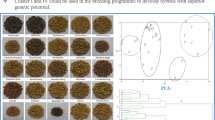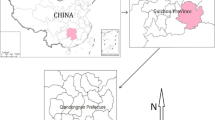Abstract
Panicle architecture is an important character that influence reproductive success and contributes directly to grain yield. In the present study, we evaluated diversity of panicle traits in 77 indigenous rice landraces from Koraput and compared with three popularity cultivated hybrid varieties of the locality for possibility of using in crop improvement program. Significant morphological variations of panicle traits such as panicle number, panicle angle, panicle weight, panicle length, grain number and grain weight were recorded in studied rice landraces. Based on the principal component analysis, first two axis of principal component captures 56.34% of the total variation and indicated significant variability of panicle traits among the genotypes. Panicle length, panicle weight, grain number and flag leaf area are the major determinants of phenotypic diversity. Multiple correlation between traits indicated that panicle weight in studied rice landraces were positively correlated with panicle number, grain number and leaf area and negatively associated with panicle length, panicle angle and chaff number. The genetic advance as percentage of mean (GAM) ranged from 22.19% for panicle length to 147.02% for panicle angle. High GAM along with heritability was observed for panicle number, panicle weight, grain number and chaff number and are important traits for selection during crop improvement. Some of the landraces such as Matidhan, Bhatagurumukhi, Chiklakoli and Kamuntana remarkably showed superior panicle weight along with higher grain number and length of panicle, which can be used in the future rice breeding program.





Similar content being viewed by others
References
Adriani DE, Dingkuhn M, Dardou A, Adam H, Luquet D, Lafarge T (2016) Rice panicle plasticity in near isogenic lines carrying a QTL for larger panicle is genotype and environment dependent. Rice 9:28
Arunachalam V, Chaudhury SS, Sarangi SK, Ray T, Mohanty BP, Nambi VA, Mishra S (2006) Rising on rice: the story of Jeypore. Swaminathan Research Foundation, Chennai, pp 1–37
Ashfaq M, Khan AS, Khan SHU, Ahmad R (2012) Association of various morphological traits with yield and genetic divergence in rice (Oryza sativa L.). Int J Agric Biol 14:55–62
Ashikari M, Sakakibara H, Lin SY, Yamamoto T, Takashi T, Nishimura A, Angeles ER, Qian Q, Kitano H, Matsuoka M (2005) Cytokinin oxidase regulates rice grain production. Science 309:741–745
Burton GW, Devane EH (1953) Estimating heritability in tall fescue (Festuca arundinacea) from replicated clonal material 1. Agron J 45(10):478–481
Falconer DS, Mackay TFC (1996) Introduction to quantitative genetics, 4th edn. Longmans Green, Harlow
Fujishiro Y, Agata A, Ota S, Ishihara R, Takeda Y, Kunishima T, Ikeda M, Kyojuka J, Hobo T, Kitano H (2018) Comprehensive panicle phenoty** reveals that qSrn7/FZP influences higher order branching. Sci Rep 8:12511
Gour L, Maurya SB, Koutu GK, Singh SK, Shukla SS, Mishra DK (2017) Characterization of rice (Oryza sativa L.) genotypes using principal component analysis including scree plot & rotated component matrix. Int J Chem Stud 5(4):975–983
Huang Y, Bai X, Luo M, **ng Y (2018) Short Panicle 3 controls panicle architecture by upregulating APO2/RFL and increasing cytokinin content in rice. J Integr Plant Biol 61(9):987–999
Ikeda K, Nagasawa N, Nagato Y (2005) Aberrant panicle organization 1 temporarily regulates meristem identity in rice. Dev Biol 282:349–360
Ikeda M, Miura K, Aya K, Kitano H, Matsuoka M (2013) Genes offering the potential for designing yield-related traits in rice. Curr Opin Plant Biol 16:213–220
Johnson HW, Robinson HF, Comstock RE (1955) Estimates of genetic and environmental variability in soybeans. Agron J 47(7):314–318
Lahkar L, Tanti B (2017) Study of morphological diversity of traditional aromatic rice landraces (Oryza sativa L.) collected from Assam, India. Ann Plant Sci 6(12):1855–1861
Lei Q, Zhou J, Zhang W, Luo J, Wu K, Long C (2018) Morphological diversity of panicle traits in Kam fragrant glutinous rice (Oryza sativa). Genet Resour Crop Evol 65:775–786
Mishra SS, Behera PK, Kumar V, Lenka SK, Panda D (2018) Physiological characterization and allelic diversity of selected drought tolerant traditional rice (Oryza sativa L.) landraces of Koraput, India. Physiol Mol Biol Plants 24(6):1035–1046
Mishra SS, Behera PK, Panda D (2019) Genotypic variability for drought tolerance-related morpho-physiological traits among indigenous rice landraces of Jeypore tract of Odisha, India. J Crop Improv 33:254–278
Mohapatra PK, Panigrahi R, Turner NC (2011) Physiology of spikelet development on the rice panicle: is manipulation of apical dominance crucial for grain yield development? Adv Agron 110:333–359
Mohapatra PP, Bhoi S, Maity TK, Majhi A, Tarafdar J (2017) Genetic variability, heritability and genetic advance studies in onion (Allium cepa L.). J Crop Weed 13(3):32–34
Nakano H, Yoshinaga S, Takai T, Arai-Sanoh Y, Kondo K, Yamamoto T, Sakai H, Tokida T, Usui Y, Nakamura H, Hasegawa T, Kondo M (2017) Quantitative trait loci for large sink capacity enhance rice grain yield under free-air CO2 enrichment conditions. Sci Rep 7:1827
Nakano H, Takai T, Kondo M (2019) Identification of quantitative trait loci for panicle structure and grain filling using a cross between indica- and japonica-type high-yielding rice cultivars. Plant Prod Sci 22(4):443–455
Okada S, Sasaki M, Yamasaki M (2018) A novel rice QTL qOPW11 associated with panicle weight affects panicle and plant architecture. Rice 11:53
Panda D, Mohanty B, Behera PK, Barik J, Mishra SS (2020) Harnessing leaf photosynthetic traits and antioxidant defence for multiple stress tolerance in three premium indigenous rice landraces of Jeypore tract of Odisha, India. Funct Plant Biol 47:99–111
Panes VG, Sukhumi PV (1995) Statistical methods for agricultural workers, 3rd edn. ICAR Publications Krishi Anusandhan Bhavan, Pusa, New Delhi
Patra BC, Dhua SR (2003) Agro-morphological diversity scenario in upland rice germplasm of Jeypore tract. Genet Resour Crop Evol 50(8):825–828
Ray A, Deb D, Ray R, Chattopadhayay B (2013) Phenotypic characters of rice landraces reveal independent lineages of short-grain aromatic indica rice. AoB Plants 5:plt032
Roy PS, Patnaik A, Rao GJN, Patnaik SSC, Chaudhury SS, Sharma SG (2016) Participatory and molecular marker assisted pure line selection for refinement of three premium rice landraces of Koraput, India. Agroecol Sust Food Syst 41(2):167–185
Sahu P, Sharma D, Mondal S, Kumar V, Singh S, Baghel S, Tiwari A, Vishwakarma G, Das BK (2017) Genetic variability for grain quality traits in indigenous rice landraces of Chhattisgarh India. J Exp Biol Agric Sci 5(4):439–455
Samal R, Roy PS, Sahoo A, Kar MK, Patra BC, Marndi BC, Gundimeda JNR (2018) Morphological and molecular dissection of wild rices from eastern India suggests distinct speciation between O. rufipogon and O. nivara populations. Sci Rep 8(1):2773
Scheben A, Yuan Y, Edwards D (2016) Advances in genomics for adapting crops to climate change. Curr Plant Biol 6:2–10
Steel RG, Torrie JH, Dickey DA (1997) Principles and procedures of statistics: a biological approach. McGraw Hill Book Inc., New York
Tripathi A, Kumar S, Singh MK, Kumar A, Karnwal MK (2017) Phenotypic assessment of rice (Oryza sativa L.) genotypes for genetic variability and varietal diversity under direct seeded condition. J Appl Nat Sci 9(1):6–9
Tripathy S, Gurung P, Sharma SD (2005) Intellectual property contribution with regard to rice genetic resources by tribes of south Orissa, India. Plant Genet Resour Newsl 141:70–73
Wang CH, Xu ZJ, **a YS, Zhang YZ, Zhen WJ, Wang H, Zhao JM (2007) Analysis on correlation between rice panicle traits and yield. Liaoning Agric Sci 3:54–56
Wang F, Chang F, Zhang G (2008) Impact of cultivar variation in density of rice panicle on grain weight and quality. J Sci Food Agric 88:897–903
Wu Y, Huang M, Tao X, Guo T, Chen Z, **ao W (2016) Quantitative trait loci identification and meta-analysis for rice panicle-related traits. Mol Genet Genom 291(5):1–14
**ng YZ, Zhang QF (2010) Genetic and molecular bases of rice yield. Annu Rev Plant Biol 61:421–442
Yoshida S, Forno DA, Cook JH, Gomes KA (1976) Routine procedure for growing rice plants in culture solution. In: Yoshida S, Forno DA, Cock JH (eds) Laboratory manual for physiological studies of rice, 3rd edn. The International Rice Research Institute, Los Banos, pp 61–65
Yoshinaga S, Takai T, Sanoh YA, Ishimaru T, Kondo M (2013) Varietal differences in sink production and grain filling ability in recently developed high-yielding rice (Oryza sativa L.) varieties in Japan. Field Crops Res 150:74–82
Zhang DB, Yuan Z (2014) Molecular control of grass inflorescence development. Annu Rev Plant Biol 65:553–578
Zhao M, Sun J, **ao Z, Cheng F, Xu H, Tang L, Chen W, Xu Z, Xu Q (2016) Variations in Dense and Erect Panicle 1 (DEP1) contribute to the diversity of the panicle trait in high yielding japonica rice varieties in northern China. Breed Sci 66:599–605
Zhou HF, **e ZW, Ge S (2003) Microsatellite analysis of genetic diversity and population genetic structure of a wild rice (Oryza rufipogon Griff.) in China. Theor Appl Genet 107:332–339
Zhou SM, Kang HX, Li QQ, Chen ZX, Zhang YF, Liu ED, Wang GL, Chen HQ, Pan XB (2014) Genome-wide association analysis on genes controlling panicle of varieties from International Rice Core Collection Bank and it breeding utilization and utilization of related genes of panicle traits in rice. Chin J Rice Sci 28(6):649–658
Acknowledgements
Regional Director, MS Swaminathan Research Foundation (MSSRF), Jeypore is highly acknowledged for providing the experimental field for the study.
Author information
Authors and Affiliations
Contributions
D.P. and N.S. designed the experiments; K.L. cultivated the plants. N.S., P.K.B. and K.L. performed the measurement of panicle traits. D.P. analyzed the data and wrote the paper. All authors read and provided helpful discussions for the manuscript.
Corresponding author
Ethics declarations
Conflict of interest
The authors declare that they have no conflict of interest.
Additional information
Publisher's Note
Springer Nature remains neutral with regard to jurisdictional claims in published maps and institutional affiliations.
Electronic supplementary material
Below is the link to the electronic supplementary material.
Rights and permissions
About this article
Cite this article
Panda, D., Sahu, N., Behera, P.K. et al. Genetic variability of panicle architecture in indigenous rice landraces of Koraput region of Eastern Ghats of India for crop improvement. Physiol Mol Biol Plants 26, 1961–1971 (2020). https://doi.org/10.1007/s12298-020-00871-6
Received:
Revised:
Accepted:
Published:
Issue Date:
DOI: https://doi.org/10.1007/s12298-020-00871-6




